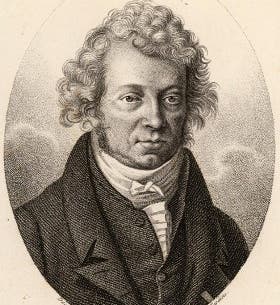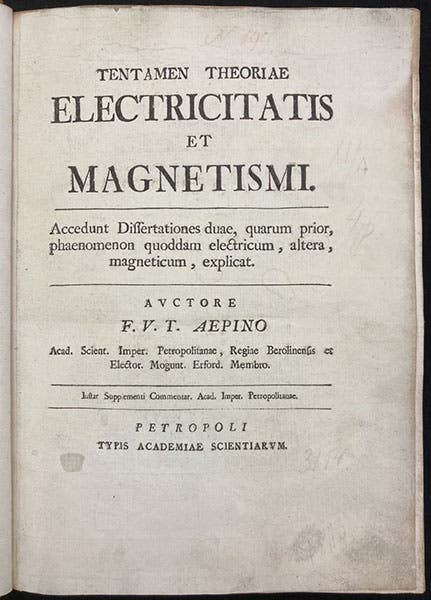Scientist of the Day - Franz Aepinus
Franz Ulrich Theodor Aepinus, a German/ Russian mathematician and experimental natural philosopher, was born Dec. 12, 1724, in Rostock, on the eastern Baltic coast of Prussia (where Tycho Brahe much earlier had lost part of his nose in a duel). Aepinus came from a long line of clerics and theologians, and indeed, if you look for his portrait on Google Images, the odds are about 20 to 1 that you will be directed to a woodcut of a 16th-century ancestor, or to his father, also a theologian. Franz was educated at the University of Rostock and taught there for a few years. One of his students at Rostock was J.C. Wilcke, who became interested in electricity about 1755, when the subject was all the rage in France and England. In particular, Wilcke showed Aepinus the wonders of the gem tourmaline, which when heated becomes electrified, like a crystallized Leyden jar. Aepinus was fascinated, wrote a treatise on tourmaline, and never looked back.
Aepinus somehow impressed Leonhard Euler, the Swiss mathematician who had worked at the Berlin Academy of Sciences since 1741, and Aepinus was invited to join the Academy in 1755, where he lived in Euler's house and began writing a book on electricity and magnetism. Aepinus was officially the astronomer of the Academy, but this must have been an honorary title, for he did no astronomy. In 1757, he was invited to Saint Petersburg by by Elizabeth, Empress of Russia, daughter of Peter the Great, and Aepinus was allowed to accept the offer (Euler had already spent some profitable time there). Aepinus remained in Saint Petersburg for the rest of his life, where he was a favorite of Catherine II, who became Empress in 1762.
Aepinus's book, Tentamen theoriae electricitatis et magnetismi (An Examination of the Theory of Electricity and Magnetism), was published by the Russian Academy of Sciences in Saint Petersburg in 1759. At almost 400 quarto pages, it was by far the most extensive treatise on the subject published to date. More significanly, it was the first time electricity and magnetism were treated mathematically, in a Newtonian fashion. Indeed, the book might well be called the Principia of electricity and magnetism. We have a fine copy in our collections, acquired from New York City bookseller Jonathan Hill in 1995.
The reigning electrical theory at the time was that of Benjamin Franklin, which was a one-fluid theory that worked very well to account for most electrical phenomena. But Franklin had believed that electrical atmospheres surround electrified objects and convey some of the forces involved. Aepinus showed, especially with his invention of the air capacitor, that there were no electrical atmospheres, and that electrical attraction and repulson acted at a distance over space with no medium involved, just like Newton’s universal gravitation.
Aepinus's Tentamen was published in Latin, in a small edition, and in St. Petersburg, so it was difficult to get a copy if you lived in England or France, especially if you did not live in London or Paris. Joseph Priestley and Henry Cavendish were both successful in borrowing copies from a London patron. Priestley dismissed Aepinus's work as of little value, betraying his lack of understanding of Aepinus. Cavendish published his own paper on electrical forces in 1771, and virtually recapitulated everything that Aepinus had written in 1759, as his own work. Cavendish said that he made his discoveries independently, and only learned about Aepinus’s work after he had finished his own paper. This has posed something of a problem for Cavendish scholars. If it had been Newton, we would just say he plagiarized Aepinus's work and lied about it. But Cavendish was not at all like the unprincipled Newton; he was extraordinarily shy and never sought credit for anything he did – indeed, much of his work was unpublished during his lifetime – so it was not in Cavendish's character to steal Aepinus's work and claim it as his own. The most likely explanation is that Cavendish got a copy of the book (and we know he did), but didn't read it, because it was written in difficult Latin, whereas nearly every other treatise on the subject was written in English or French. It would have been easier to leave it unread than to plow through it, especially since much of Aepinus' book was concerned with magnetism, in which Cavendish had no interest.
Aepinus has never, to this day, received the credit he deserves for taking electricity and magnetism out of the hands of showmen and turning it into a grown-up science. It is difficult to even find a portrait of him – the two online that seem to be real have no documentation (and the portrait on Wikipedia is that of his father). One hopes there is a true oil portrait somewhere in Saint Petersburg that just hasn’t made it online yet. Perhaps fans of Mikhail Lomonosov, a contemporary and rival of Aepinus at Saint Petersburg, and a true, native-born Russian, have conspired over the centuries to keep Aepinus out of the limelight. But if so, that has gone on long enough. Lomonosov has several statues in Saint Petersburg and Moscow. It is high time that Aepinus got one. Even a bust would be nice.
William B. Ashworth, Jr., Consultant for the History of Science, Linda Hall Library and Associate Professor emeritus, Department of History, University of Missouri-Kansas City. Comments or corrections are welcome; please direct to ashworthw@umkc.edu.









